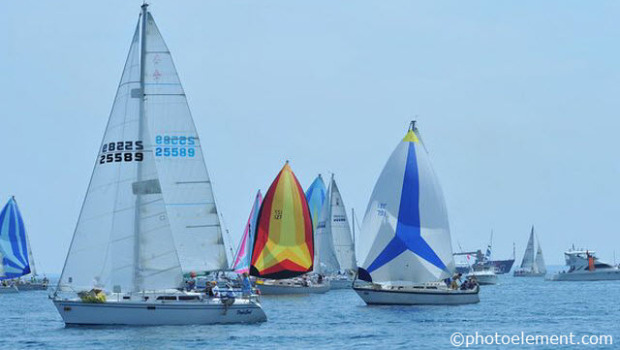Handicap Racing: A way forward for the masses?
Published on November 11th, 2014
by Dobbs Davis, Seahorse magazine
The great majority of big boat sailors in the USA – over 20,000 boats by some estimates – race locally and use Performance Handicap Racing Fleet (PHRF) handicaps issued by one of some 40 local boards scattered throughout the US. PHRF is an empirical-based ‘everyman’ system, where anything can be rated, there’s no overt typeforming, the ratings are usually one single number, and certificates are cheap, usually less than $40. The rating process is also simplified by measurement data being declared by the applicant, with no (costly) input from measurers required.
Since it is intended to be a simple entry-level approach there are also some simple guidelines for its intended use. Some fleets encourage boats to participate as long as they are kept in production trim, in other words are not modified from the builder specifications. This is intended not only as a cost control measure, but it helps in assessing the performance of a large group of boats that are truly in the same trim. Moreover, any declared variations from their designer specs ¬ larger sails, different appendages, taller rigs and so on – are assessed rating ‘penalties’ in rather large fixed increments (eg 3 sec/mile ¬ PHRF ratings are most commonly expressed in time-on-distance format).
Being locally administered and controlled, and usually by the voluntary efforts of a local board, PHRF ratings are therefore a reflection of the relative performance of the local sailors in their local fleet sailing in their local conditions. All good, right?
Well, not really… there are some serious inherent flaws to this approach. One is when new designs enter a local fleet they typically get assigned PHRF ratings that are often intentionally fast in order to protect the existing fleet until some performance data becomes available. This can be severe enough to inhibit local dealers from selling these new designs. Another is when boats travel from one fleet to another and get assigned a rating that is completely different from their home fleet … or if a small variation is made to improve the performance of a boat but the rating change is too punitive … or the composition of the local board is such that there may not be disinterested parties involved.
Another interesting effect is where an acceptable rating is assigned to a given boat type, but this boat type is then campaigned by a pro-level team who simply prepare their boat and gets it around the course better than in any previous attempt. This team can thus win everything by huge margins and the local committee is powerless to act, since the boat’s rating is so well-established.
On the larger scale, frustrations with these problems have in the past been the driving force to create level rating classes and, more recently, the advent of new one-designs. But the market has been fairly saturated for new one-designs, and at the local level there are rarely the numbers needed to create viable one-design fleets (except maybe J/70s, which have attracted owners from all backgrounds!).
A combination of all these factors is thought to be suppressing participation numbers, to the concern of race organizers and industry members. But there’s good news: help may be on the way.
In organizing the fifth Annapolis Big Boat Regatta, an end-of-season favorite in early November that has attracted entries to race under HPR and IRC handicaps, race managers from the Storm Trysail Club in the Chesapeake are also trying to lure more of the local-based fleet to join the fun. This is a group of mostly production cruiser-racers, many of whom have lost faith in the single-number solution PHRF offers and are looking for something with just a little more technical meat to fairly rate their boats.
“I want to get my customers excited again about racing,” says Ken Comerford of North Point Yacht Sales, the Annapolis dealer for J/Boats. ”They have been frustrated lately with the ratings and results, so we’re looking for some new solutions to motivate them to come back out to race.”
The organizers first looked at trying ORC Club handicaps, but since this is not supported by US Sailing, the rating office is prepared to offer a new and clever blended approach to performance-based and science-based ratings.
Using sources of data that range from what is shown on a PHRF certificate to measured data from ORR certificates (or other credible sources), the office is planning to devise handicaps that will give ratings for windward/leeward courses in Light, Medium and Heavy wind (similar to ORC’s triple number ratings) and a general-purpose offshore rating devised for multiple wind ranges and angles. Storm Trysail race managers also plan a varied menu of races for their three-day event in which it’s likely that all options will be used.
These blended ratings would be expressed in time-on-time format to help eliminate biases due to sizing and variable wind and current conditions, and the entries will have to have their sails measured to provide an adequate minimum level of data that is specific to their boat.
“We have the tools to make this work, so this will be a good test of how to use them to better serve the more discriminating local fleets,” said Bill Lee, chairman of the Offshore Big Boat Race Management Committee of US Sailing. “These fleets are important, as they are where new players come into the sport, and we need to lure them into the game without too much complication but also with accuracy. This approach will also bolster our effort to get wider acceptance of the UMS concept to gather more solid measurement data from the US fleet.”
If successful, this could be a needed shot in the arm not only for local events in the US, but for the major travel events as well who have relied in the past on large PHRF fleet for entries, but have had problems with keeping their interest. Better consistency and accuracy in handicapping for these mid-level competitors might yet help bring them back.
NOTE: This column was re-published with permission from Seahorse magazine. Information about Seahorse can be found HERE.









 We’ll keep your information safe.
We’ll keep your information safe.